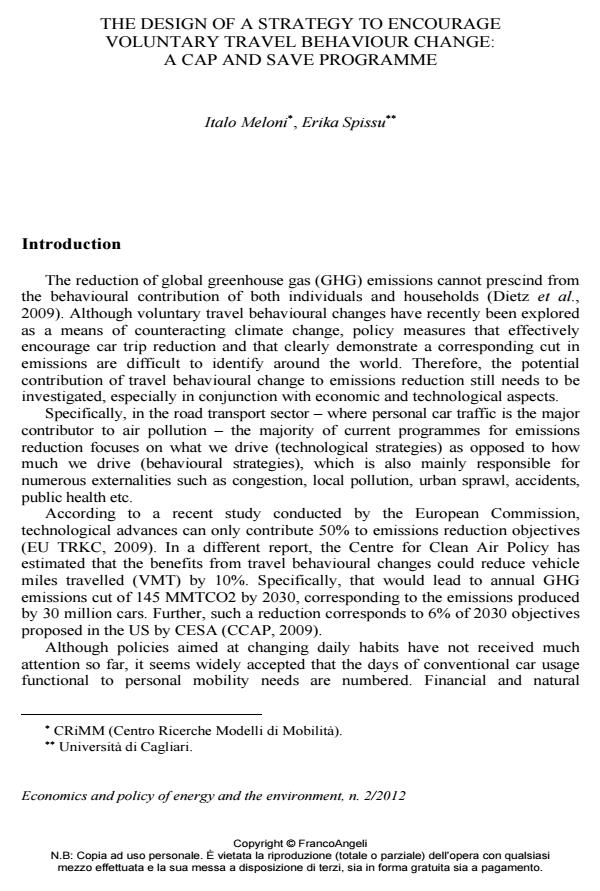The design of a strategy to encourage voluntary travel behaviour change: a cap and save programme
Journal title ECONOMICS AND POLICY OF ENERGY AND THE ENVIRONMENT
Author/s Italo Meloni, Erika Spissu
Publishing Year 2012 Issue 2012/2
Language English Pages 20 P. 11-30 File size 817 KB
DOI 10.3280/EFE2012-002002
DOI is like a bar code for intellectual property: to have more infomation
click here
Below, you can see the article first page
If you want to buy this article in PDF format, you can do it, following the instructions to buy download credits

FrancoAngeli is member of Publishers International Linking Association, Inc (PILA), a not-for-profit association which run the CrossRef service enabling links to and from online scholarly content.
The objective of this work is to explore the contribution of daily activity-travel patterns to carbon emissions, and to define the steps for the implementation of an effective behavioural strategy to encourage voluntary travel behavioural changes. This work proposes an extensive review of the most relevant strategies implemented to achieve sustainable objectives. In particular, the focus is on those strategies aimed at changing human behaviour, debated both in transportation (Structural strategies) and in sociological and psychological (Cognitive-Motivational strategies) fields. Further, international experiences of Voluntary Travel Behavioural Changes programs, as opposed to compulsory measures (i.e. taxation, restrictions etc.), are investigated. Finally, the work describes the results of a pilot survey held in Cagliari (Italy) to test a behavioural strategy called "Cap and Save". The basic idea of the Cap and Save is that voluntary travel behavioural changes are more likely when the individuals are able to recognize a personal profit. The Cap and Save program combines a number of key aspects from behavioural strategies reviewed in the literature (i.e. Tradable Exploitation Rights, Personal Journey Planning etc.): first, individuals are free to modify their behaviour; second, a cognitive-motivational process is set forth to increase awareness of sustainable behaviours. Third, each individual receives an annual emissions limit (cap) and a monetary incentive (save) to reduce emissions; fourth, a set of personalized alternatives is tailored for the individual in order to reduce weekly mileage. Finally, the Cap and Save program relies on an accurate analysis of activity-travel behaviour before and after policy intervention. The initial test of the Cap and Save programme was conducted during a two-week survey (July-October 2009), which involved a group of students from the University of Cagliari (Italy). The first week, the students were invited to record their actual daily activity-travel patterns. The second week, they were asked to repeat the survey, this time they were challenged to maintain a weekly cap of kilometres travelled thereby saving the corresponding resources (i.e. environmental and monetary). Each student was provided with a set of personalized alternatives, which (if followed) would result in a 20% reduction of kilometres travelled. The comparison of before and after strategy implementation highlights the implications of Cap and Save on a wide range of individual daily activities and, specifically, on personal car usage.
Keywords: Behavioural strategy, Voluntary travel behaviour change programme, Cap and Save, Activity locator
Jel codes: Q56, R48, O18
Italo Meloni, Erika Spissu, The design of a strategy to encourage voluntary travel behaviour change: a cap and save programme in "ECONOMICS AND POLICY OF ENERGY AND THE ENVIRONMENT" 2/2012, pp 11-30, DOI: 10.3280/EFE2012-002002